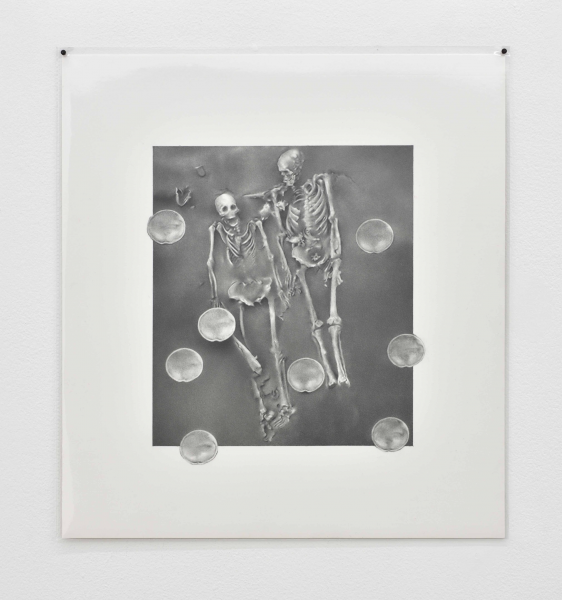
Harappa joint burial site, Haryana, India. 2500 BC. (source: Vasant Shinde)—repeated earthen plate,
2019–2020, graphite on paper, 37 × 34 cm (incl. border)

When I think about Xavier I think about the distinction between excavation and composition – you compose an image and then you must use the tools you have to excavate it. You can get facility with one or the other and Xavier is magnanimous when I bitch with him about other artists I think are sloppy; he says that composition also is important. He is right, but I think that it is the work of excavation that hooks his pictures into the untimed spaces that he moves around in circles in his shows. He tells me stories about weeping, and about dedication, and a rigorous commitment to formalism over many years. Composition is dramatic and demonstrative and discursive – composition is the predator smile from the fox’s head in my favorite of his drawings Magic Mountain.
It is also the condition of digitality that insists against the formalism of everything X produces, and that makes his drawings sharp and timely. It holds the pictures in tension inside of their framing. But it is not so uncommon to find young, intelligent artists with this fluency – our training is obsessed with the choppy endless churn of formal experimentation. It would be trite to insist on mastery of form as some point of difference and I want to avoid this at all costs – I think that instead of an appeal to conservatism or formal stability (a good investment), it is the slippage outside of productive, critical time that animates this process that I have called excavation.
Watching X in the studio, working under the big lights, is like watching a technical (even industrial) process, and his shows and texts are contextualised by this commitment to a time scale that cannot be dissected using our readymade critical tools – at least not without bad faith caricature. We have spoken often about this type of dumb informal conversation that seems to power the whole apparatus that X produces in; that we here at school think we recognise as the enemy.
…
Composition is timely; it is in communication with the way we live now and its conditions are essentially digital and discursively distributed. Excavation is technical work and cannot be rushed – not only because it is difficult and laborious, but also because there are conditions built into the process that X understands, and that as far as I know he has never attempted to describe to anyone. I suspect that they are not easily accessible with language. They are everything in his pictures that is against sequence – it is primarily excavation that affords those slippages that move the images beyond the conditions of their history and display.
Excerpt from Essay by Louis Mason

Harappa joint burial site, Haryana, India. 2500 BC. (source: Vasant Shinde)—repeated earthen plate,
2019–2020, graphite on paper, 37 × 34 cm (incl. border)
